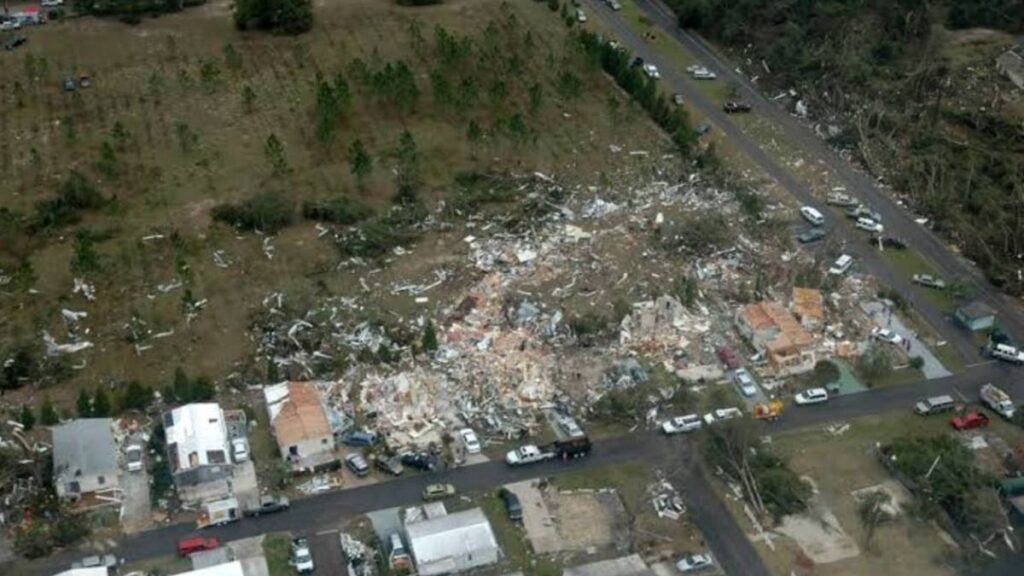Last week, a severe storm wreaked havoc in some US southern states. The storm came with heavy rain and, in some parts, heavy hail; it also led to tornadoes, which damaged towns.
So far, reports say there are four fatal casualties and many records of injuries. Many victims lost their houses and properties to the strong winds and tornadoes.
Likewise, many roads and schools are under closure, and many Americans are experiencing disconnection from public utilities thanks to the widespread damage.
Many activities have been grounded, as many are holed up in their homes, for those who still have what can be called a viable shelter. Airports are not left out either, as about 20,000 have so far experienced delays, and 2,000 have been outright canceled.
In Florida alone, the National Weather Service verified that at least three large tornadoes swept through the state. The resulting storm had an average wind speed of about 107 mph. These realities forced Gov. Ron De Santis to declare a state of emergency in 49 of the 67 counties in Florida.
ALSO READ: Heavy Storm Forces Evacuation as Water Levels Rise in Northeast Rivers
However, the Storm Prediction Center suggests that the worst is not yet over. According to their predictions, southern states should braze up for more severe weather conditions in the coming weeks.
The city of Marianna, Florida, particularly took some serious beating from one of the three tornadoes that went through the state. With a 6,200-strong residency, Marianna was left in shambles as the strong whirlwind crossed through.
In fact, a storm chaser posted a video on X showing many vehicles and campers on the Marianna interstate turned over.
POLL — Is Climate Change a Major Threat That Requires Immediate Policy Action?
Tallahassee is one of the cities observing a state of emergency. Gov. DeSantis was there on Tuesday and addressed residents from the Capitol. DeSantis assured all Tallahassee residents that the government would offer whatever support they could as the city exited the storm. He equally directed that all public buildings, except the Capitol, should be under lock and key.
DeSantis also clarified that he had declared a state of emergency in Tallahassee to ensure that every victim of the tornadoes could get assistance.
In the Pacific Northwest, the storms came in the company of heavy snowfall. Andrew Kienzle, a meteorologist with AccuWeather, predicts that states like Idaho, Iowa, Washington, and Oregon may experience snowfalls averaging 24-48 inches.
ALSO READ: “Biden Hitting New Low!” Conservatives Fume as NYC Schools Close to House Immigrants
However, in states like Washington and New York, the weather service estimates that there will be heavy rainfall after the blizzard. In essence, the immediate succession of heavy rain, up to 4.0 inches, after considerable snowfall is likely to cause widespread flooding in the two states.
In the wake of the weather crisis in Florida, the Tallahassee office of the National Weather Service will send out tornado survey teams. These folks will assess the gravity of damages caused by the tornadoes in counties like Jackson, Bay, and Walton.
At the moment, the important thing is for the vulnerable states and counties of the south to brace up for the severe weather projections for the new week. As Gov. DeSantis said in his Capitol speech, folks must remain resilient and forge through these literal storms together.
You Might Also Like:
Fauci Admits to COVID-19 Failures, Says Lab Leak is Credible
Americans React as Viral Video Shows Biden Proposed a Border Fence in 2007
Biden Administration To Reform Soaring Cost of College Fees by Curbing Hidden Charges
Ron Desantis Blasts Biden and NYC for Sending Students Out of School for Illegal Migrants
US Air Force Fighter Pilot Enters Miss America Contest
